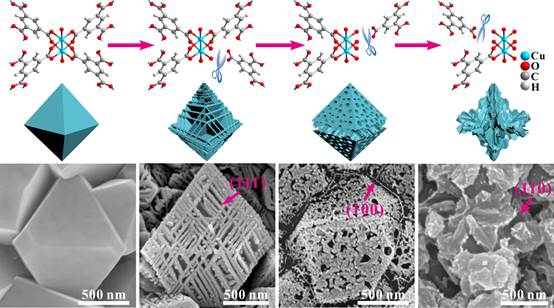| Coordination mode engineering in Pyramid-like MOFs |
| From: PublishDate:2020-07-31 Hits: |
Metal–organic frameworks (MOFs), as a kind of porous material, have received increasing interest in catalytic application due to their fascinating structure. However, systematically engineering coordination modes of metal sites in MOFs and establishing the exact structure-to-property correlation between coordination and catalytic activity remains challenging. Prof. Wang tie's group from the Institute of Chemistry of the Chinese Academy of Sciences and Prof. Lin Zhenyu from Fuzhou University have gained insight into the coordination modes and their catalytic reactivity in MOFs. Their research has been published on June 25th, 2019 in Nature Communications. Guided by theoretical calculation, the research team found that the three-coordinated Cu sites have the highest activity among the four coordination states (four-, two- and one-coordinated sites). Subsequently, they developed a facile etching strategy for preparation of three-coordinated Cu sites on the surface of MOF by selectively etching the classical MOF along the (111) facets. After etching along different facets, Cu sites with four different coordination modes were successfully obtained. The highly active three-coordinated Cu sites were effective for important cycloaddition reaction of CO2, inducing activity markedly exceeding the maximum values of previous reported catalysts. In addition, because the three dimensional MOF nanosheet-assembled pyramid enables distribution of the stress or strain developed during the chemical reaction, the MOF heterogeneous catalyst could maintain undiminished activity for a long time.
Structure of MOFs with different coordination modes are determined and analyzed by XAFS carried out at 1W1B-XAFS station of BSRF. The etching effects and the underlying structural modifications were identified by qualitative and quantitative EXAFS analysis. Based on the analysis of XANES spectroscopy and theoretical simulation, the 3D arrangement of atoms at the defective Cu site structures were obtained. The clear structural analysis laid a solid foundation for the later study of the relationship between structure and performance. The research, a facile “cutting” strategy to obtain low-coordinated and high active copper sites, not only provides a highly efficient and stable catalyst for carbon fixation, but also pays the way to dig out the relationship between metal coordination modes and their activity in MOF. In such a research, synchrotron sources are the key to unveil the complex structures. "Studying the coordination engineering in MOF crystals can provide inspiration for the design of other nanocatalysts, and the foundation is the exact structure identification on the basis of synchrotron radiation technique. Such a strong technical support enables us to conduct a series of researches on structure-property-function and achieve numerous progresses. More brilliant synchrotron beams can surely help to demystify the physical world." explains Wang Tie, the team leader and the professor of Institute of Chemistry, Chinese Academy of Sciences. Article: Chuanhui Huang, Juncai Dong, Weiming Sun, Zhenjie Xue, Jun Ma, Lirong Zheng, Cong Liu, Xiao Li, Kang Zhou, Xuezhi Qiao, Qian Song, Wende Ma, Lan Zhang, Zhenyu Lin* & Tie Wang*. Coordination mode engineering in stacked-nanosheet metal–organic frameworks to enhance catalytic reactivity and structural robustness. Nature communications, 2019, 10(1): 1-10. |
|
|
| Chinese
- Metal-free efficient photocatalyst for stable visible water splitting——Top ten major scientific progresses in China in 2015
- The nano-resolution imaging platform was awarded the first rate prize of Beijing Science and Technology in 2014
- Beamline 1W1 of BSRF started to runoperate in the couplingparasitic mode of BEPCII
- Synthesis of High Performance Polymer Materials for Field Effect-Transistors
- Surfactant molecular aggregates in green solvents
- GIXRD has played an important role in the characterization of organic thin-film transistors
Science Highlights
Home /
Copyright © 2011 - 2012 Beijing Synchrotron Radiation Facility


